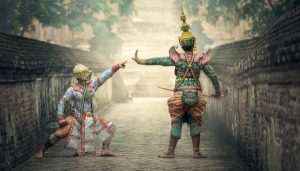
If an opponent managed to brush off the misdirection, stealth, and ruses of the ninja, a final obstacle would present itself: Tai-Jitsu. Within the wide range of abilities ninjas acquired through their harsh training regime, Tai-Jitsu, a martial art for unarmed combat, was of paramount importance. The ninja would use the martial art as a last resort to defeat his bewildered enemy and meld into the darkness. The modern fascination with shadow warriors has led to the preservation of many Tai-Jitsu techniques, including striking, grappling, and evasion.
Frequently faced with the armored carapace of the samurai, ninjas focused on exploiting the weaknesses in the human anatomy. Kicks and hand strikes utilized fluid movement, coupled with deadly precision, to generate maximum power. Pressure points also worked to the ninja’s advantage; where a slight touch could force an exaggerated reaction. A blow to the abdomen nerve clutch called the solar plexus, for instance, could drive the breath from a grown man with minimal effort. Faced with the striking capabilities of the ninja, an inexperienced enemy might reason they would fare better by closing the distance and grappling with the ninja. They would find themselves sadly mistaken.
Grappling techniques emphasized leverage and body positioning to overpower stronger and larger opponents. Through a thorough understanding of the human anatomy and physiology, the ninja could manipulate his opponent’s body while grappling. Joint locks, such as hyper-extending the elbow or dislocating the shoulder, could effectively disable opponents within moments of contact, allowing the ninja to escape. Likewise, chokes, or cutting off air supply by pushing on the windpipe, and strangulation, or restricting oxygen to the brain by applying pressure to the carotid arteries, could force an opponent into unconsciousness. The lethal combination of grappling techniques in the ninja’s arsenal was enough to make seasoned warriors hesitate before engaging.
Evasion techniques exploited the ninja’s predilection toward mobility. The break falls and rolls created unpredictable movement patterns in the midst of combat. Capitalizing on their opponent’s momentary confusion or over-extension, the ninja could then choose to disengage or execute a lethal strike. The acrobatics had the additional advantage of honing the ninja’s spatial awareness; meaning they could easily regain their feet and use unstable environments, like woods or cluttered rooms, to their advantage. The heavy use of evasive techniques set Tai-Jitsu apart from most other martial arts of Japan.
The art of Tai-Jitsu was one skillset set among many required for the ninja to succeed in their missions. The ability, however, to defend themselves without weapons allowed ninjas to operate with confidence. Even stripped of their clever tricks and unique equipment, the ninja could still be a formidable advisory. The many modern dojos that continue to uphold the traditional teachings of Tai-Jitsu stand as testament to the effectiveness of the ninja’s unarmed combat skills.




Free 2-Day Shipping!
all USA orders